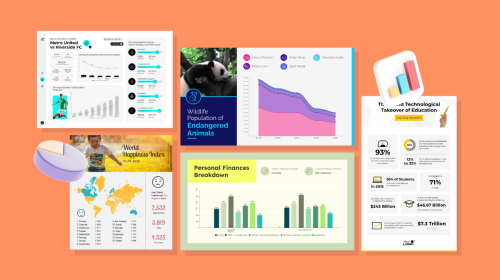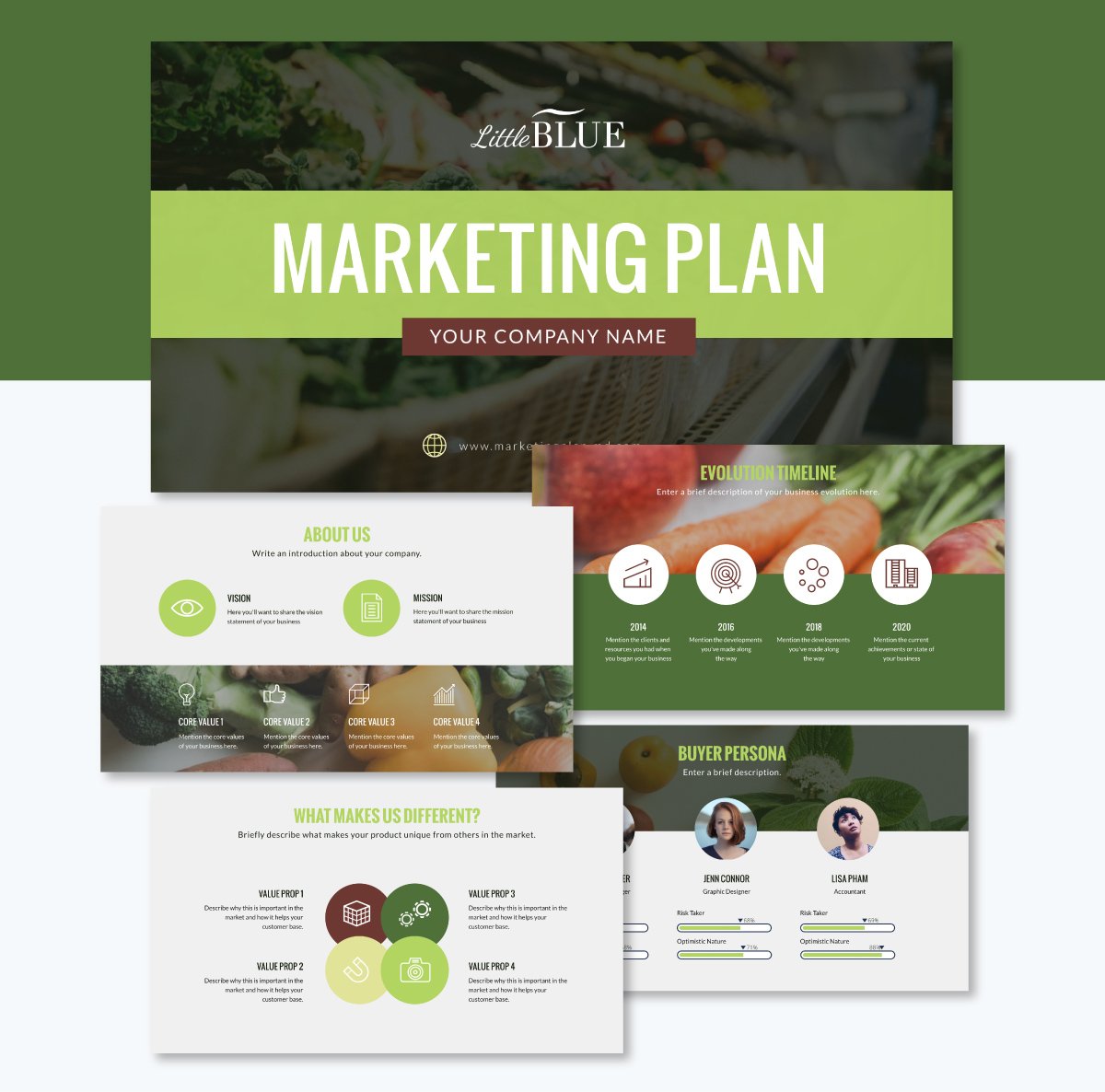
6 Marketing Plan Examples & Actionable Tips to Follow


Anyone can organize ideas into a marketing plan, but turning those ideas into tangible impact? That’s where most teams fall short.
According to CoSchedule’s State of Marketing Strategy Report, organized marketers are 674% more likely to report success. Yet only 47% of marketers say parts of their strategy are documented.
Marketers who take the time to build structured, actionable plans are far more likely to hit their goals. It’s how big ideas take shape, teams stay aligned and get real results.
But creating a solid plan doesn’t mean starting from scratch. By learning from real-world marketing plan examples, you can shortcut the process, avoid common pitfalls, and spark fresh ideas tailored to your goals.
In this guide, we’ll walk you through a variety of marketing plan examples to inspire yours. You’ll also find actionable tips you can apply right away and ready-to-use templates to get you started quickly.
And if you're looking for a quick, visual walkthrough, this video has you covered. It’ll show you exactly how to build a marketing plan that sets you up for success.
A marketing plan is a structured roadmap that outlines how a business will reach its target audience, promote its products or services and achieve specific goals.
It aligns your team around clear objectives, defines the strategies you'll use and provides a framework for measuring progress and making adjustments.
A sound marketing plan helps prioritize resources and ensures every action you take supports a bigger strategy.
As Eric Ries, entrepreneur and author of the New York Times bestseller The Lean Startup, notes,
“Startups that succeed have a clear and actionable marketing plan that is integrated into the overall business strategy. A great marketing plan doesn't just push product, it helps build relationships with customers and aligns with their needs.”
Marketing plans are typically multi-page documents, but there are instances where a one-page marketing plan would be more impactful.
For example, in situations where key stakeholders require a high-level overview, it is essential to concisely summarize all critical information on a single page.
Here’s a one-page marketing plan template to give you an idea of how to structure yours.
A solid marketing plan usually covers these key elements:
You’re probably wondering: What does a marketing plan look like? In this section, we’ll share 5 real-life examples from top companies.
Lake Oswego’s strategic marketing plan is a solid example for any local government or community-focused organization seeking a plan that is not only well-written but also ready for implementation.
Visually, it’s clean, consistent, and on-brand from the font choices to the color palette. Everything feels intentional, which makes it not just easy to follow but also enjoyable to read.
What really makes this plan stand out is how well it lays the groundwork. It walks you through the planning process, shares key findings from a SWOT and competitive analysis, and uses that data to back up the strategies that follow. It clearly outlines customer segments and target audiences, showing a focused, well-researched approach to outreach.
The main section of the plan revolves around 12 core strategies. And it’s not just theory, there’s real guidance here on execution, timelines, and resource allocation.
To wrap it all up, the plan includes a detailed budget and metrics to track progress and measure results. This helps keep the team accountable and makes it easier to tweak things along the way.
The Silver Key Marketing Plan is an excellent example for nonprofits focused on securing donors and building community relationships.
The 63-page marketing plan embraces a detailed approach. Much of its length comes from a thorough breakdown of marketing initiatives, outlining each initiative alongside the strategies and channels used to achieve the organization’s goals.
Its strength lies in its easy-to-read format, using bullet points and short paragraphs to present information clearly. While many marketing plans rely heavily on charts and graphs, this one manages to be engaging and informative without leaning on those visual aids.
Overall, the Silver Key Marketing Plan demonstrates how a detailed, well-structured document can still be accessible and engaging.
The San Diego and Imperial Counties Community College Association (SDICCCA) Three-Year Marketing Plan serves as a strong model for colleges seeking to increase enrollment in career education programs.
The plan outlines strategies and anticipated impacts that will influence the college’s long-term development. To support this forward-looking perspective, it incorporates timelines and charts that offer a clear view of projected outcomes.
The plan not only highlights digital marketing as a key strategy for attracting students but also presents examples of how the website and ads will appear across digital channels. The visuals are not excessive but serve as essential tools to illustrate the strategy clearly.
Overall, the SDICCCA Three-Year Marketing Plan demonstrates how a strategic approach, supported by thoughtful visuals and detailed projections, can drive long-term success in career education enrollment.
The Santa Barbara Metropolitan Transit District’s branded visual marketing plan is a standout example for any transit agency aiming to build brand awareness and increase ridership.
It demonstrates how a transit organization can effectively incorporate a clear SWOT analysis, define target markets, and implement multi-channel marketing strategies to achieve its objectives.
What makes this plan unique is its visual layout. Unlike Silver Key’s top-to-bottom readable format, Santa Barbara’s plan takes a more dynamic approach, placing content along the margins and using varying font sizes and spacing to guide the eye. The result is a layout that’s visually engaging yet easy to navigate.
The design also reflects the local spirit of Santa Barbara. A cool blue color palette, combined with imagery of the ocean and surrounding landscape, ties the brand to its environment and adds emotional resonance.
Whether you’re in the transit sector or a completely different industry, this plan serves as a strong reference for organized content, targeted messaging and a cohesive visual identity.
Keller Williams takes a client-centered approach tailored specifically to attract real estate sellers.
What caught my attention was the 14-Step Marketing Plan laid out on a single page. Each step explains how the company will market a home and ensure it gets maximum exposure across the right channels.
While it omits traditional components like an executive summary or SWOT analysis, its brevity is a strength. It gets straight to the point, answering the key questions that potential clients are likely to have.
The plan works even better because it uses custom visuals, regular progress updates and helpful data to keep clients informed and confident throughout the selling process.
This clear and focused approach shows why Keller Williams does real estate marketing so well.
The City of Romulus’ marketing plan serves as a strong reference for community development agencies and local government organizations.
It covers a broad range of initiatives, including business attraction, job placement, and infrastructure development. A clear SWOT analysis plays a key role in organizing the city’s many goals and actions, providing a structured approach to a complex set of objectives.
Another standout feature is the effective use of graphs and charts. When presenting data on income, demographics and employment rates, these visuals make complex information easy to digest and enhance the overall clarity of the plan.
With its organized format and strategic presentation of information, the City of Romulus’ plan is a valuable model for community planners or anyone aiming to bring multiple ideas and initiatives into a cohesive marketing strategy.
It's common to confuse a marketing plan with marketing strategies, but a strong plan is always built on a solid strategic foundation.
Marketing professional Laurie Katapski emphasizes the importance of this approach:
“Developing your marketing strategy first ensures that every action you take is purposeful and aligned with your business goals. This planned approach transforms impulse into strategy, providing your marketing efforts with a focused direction.”
To illustrate how a solid strategy translates into action, here are six real-life marketing strategies.
From social media campaigns to data-driven outreach, these examples demonstrate how the right approach can elevate brand awareness, engage audiences, and drive impactful results.
Apple TV’s Severance is the streaming service’s most-watched show, a success that might not have been possible without its brilliant marketing strategies. One of the most notable strategies was its innovative use of social media.
The show is a workplace thriller centered around Lumon Industries, a mysterious company that surgically severs its employees’ work and personal lives to carry out their secretive operations.
To immerse audiences in the world of Severance, the marketing team created a LinkedIn page for the fictional Lumon Industries, posting in-character updates as if the company were real.
Similarly, in Severance, Lumon Industries uses carefully crafted messaging to draw people deeper into its themes of corporate control and identity. This example shows how powerful storytelling can shape perception.
Spotify Wrapped is a clever omnichannel marketing strategy that dominates headlines, social media conversations and cultural discourse every year.
Every December, users get an annual personalized recap that showcases their top songs, artists, genres, and listening habits from the past year in a shareable format.
The results? Massive social media engagement, with Spotify Wrapped hashtags trending globally every year. Millions of free PR impressions through news coverage and influencer shares. Plus, a significant boost in app downloads and user re-engagement, as even inactive users return to explore their Wrapped.

Uber Eats has mastered the art of email marketing by blending personalization, humor, and strategic PR tactics to keep customers engaged and drive sales. Their email campaigns don’t just promote discounts or new restaurants; they create buzz-worthy moments that generate free publicity and keep Uber Eats at the center of online conversations.
This approach leads to increased customer loyalty and re-engagement, as users feel Uber Eats understands their preferences, making them more likely to continue using the service.
By using personalized messages and working with strategic partners, the brand builds a stronger connection with its audience.

Thousands of travel-related search results have been led by TripAdvisor through their SEO-driven marketing strategies.
Rather than spending on ads, it focuses on getting free traffic by optimizing reviews, using the right keywords, and improving local search results. This helps TripAdvisor show up at the top of Google searches when people look for hotels, restaurants, or attractions.
By using user-generated content, smart keyword choices, organized data and local SEO tactics, TripAdvisor has built a strong system that brings in millions of visitors every month without relying on paid ads.
This strategy not only boosts its credibility and trust among travelers but also solidifies its position as one of the most influential platforms in the global travel industry.

What’s fresher than Chipotle’s food? Their brand strategy. They mix authenticity, digital engagement, and purposeful messaging to connect with customers.
Instead of relying on big discounts and ads like most fast-food chains, Chipotle focuses on storytelling, social media and being transparent to build customer loyalty.
At the heart of Chipotle’s branding is its commitment to "Food with Integrity." The company markets itself as a healthier, more sustainable alternative to fast food by emphasizing the quality of its ingredients.
This strategy has helped the company build strong brand loyalty, maintain cultural relevance, and differentiate itself in the highly competitive fast-food industry.
Known for its over-the-top, experiential marketing strategies, Taco Bell is a master at launching new menu items or limited-time offers. The brand doesn’t just announce new products; it creates hype-driven events, influencer collaborations and viral ad campaigns that make every launch feel like a cultural moment.
One of the most iconic examples of Taco Bell’s launch event strategy was the Nacho Fries campaign. Instead of a standard fast-food announcement, Taco Bell treated Nacho Fries like a Hollywood blockbuster. This approach blurred the lines between advertising and entertainment, making the campaign go viral. The success of the campaign led to several sequels over the years, further cementing the Nacho Fries as a fan favorite.
Taco Bell’s launch events are bold, fun and designed to create viral moments. The brand consistently finds ways to make its menu items feel like must-have cultural phenomena rather than just fast food.
View this post on Instagram
Dunkin’ struck gold when it partnered with Charli D’Amelio, one of TikTok’s biggest stars, to create a highly successful influencer-driven marketing campaign. The collaboration not only boosted Dunkin’s brand awareness among Gen Zs but also led to record-breaking sales and engagement.
Charli D’Amelio, who has over 150 million followers on TikTok, was already a devoted Dunkin’ fan. Her organic love for the brand made her the perfect influencer for an authentic, high-impact campaign.
Recognizing her influence, Dunkin’ officially partnered with Charli in 2020, launching her signature drink, “The Charli.” The campaign was designed to blend influencer culture with social media marketing, targeting young consumers who admire Charli’s lifestyle and habits.
The campaign sparked a viral social media challenge, drove record app sign-ups, and boosted brand loyalty, as Charli’s fans connected Dunkin’ with their favorite influencer.
Now you’ve seen examples of marketing plans and how companies have brought their plans to life. Let’s structure one together.
We’re here to offer [product/service] that helps [target audience] achieve [goal] without sacrificing [valuable asset: time, budget, peace of mind]. Our main focus is to build brand awareness, grow our digital presence, and connect with our audience in an authentic way. We want people to not only recognize our brand but to feel like they’re part of our community.
For instance, if you are prioritizing digital marketing, your KPIs might include:
To measure success, we've set the following goals:
We tailor our marketing to the following ideal customer profile:
These are just a few categories to start from. What’s important will depend on your business and the services you offer.
After recognizing your competition, you can analyze their strategies and channels. What works and what doesn’t work?
To stand out, we assess our competitors by:
Set clear, measurable goals using the SMART framework.
Dive into key strategies and the channels used to reach target audiences:
We will allocate [$X] per month across the following marketing efforts:
Create a roadmap for executing the plan.
Summarize your key points and leave a lasting impression on the reader. Reinforce the plan’s goals, expected outcomes, and next steps.
With this marketing plan, [Your Business Name] aims to [achieve primary goal] through focused strategies and smart execution. By implementing [marketing strategy], we expect to complete [goal] within [timeline].
After reviewing real-world examples of marketing plans and strategies, now it’s time to develop your own. Explore these four marketing plan templates designed to help you bring your vision to life.

This SaaS marketing plan template is designed for software companies aiming to drive growth and user engagement. It features key sections like customer acquisition strategies, competitive analysis, and revenue projections.
With a professional yet vibrant layout, you can easily customize it to match your brand.

This e-commerce marketing plan template is perfect for online businesses looking to strategize their growth. It includes key sections like market analysis, target audience insights, and conversion strategies.
With a sleek, modern design, it’s easy to customize with your brand colors and content. Simply edit online in Visme and create a compelling marketing plan to boost your online sales.
And if you’re working with a team, our collaboration and workflow features make it easy to stay organized and on the same page throughout the process.

Whether you're in the fashion or food industry, the LittleBlue Marketing Plan Presentation template lets you showcase your marketing goals with a clean, modern, and eco-friendly design.
Easily edit this marketing plan presentation online in Visme to create a powerful and effective slideshow. Once finalized, you can print the slides and share copies with your team for seamless collaboration.
To make the creation process even easier, Visme offers a powerful suite of AI tools that streamline every stage of your workflow. From generating written content to suggesting design layouts, these intelligent features will bring your marketing plan to the next level.
With less time spent on formatting and more focus on strategy, you can create a clear and compelling presentation that’ll resonate with any audience.

If you're looking for something concise and straight to the point, this one-page marketing plan is a perfect choice. This template allows you to clearly outline your objectives and list key marketing strategies, all in an easy-to-reference format.
If you need help creating visuals like the one above, you can count on Visme’s data visualization tools to make it painless.
These are just a handful of the 150+ marketing plans we have. Explore more here to find the perfect fit for your team and strategy.
A business plan outlines a company’s overall goals, operations, and financial strategy, while a marketing plan focuses specifically on how the company will attract and retain customers through targeted marketing efforts. In short, a marketing plan is one key component within a broader business plan.
A basic marketing plan may suffice, but to elevate your strategy to greatness, ensure you cover these key elements:
Before you even begin writing a marketing plan, it’s essential to lay the foundation. Start by identifying your business objectives, goals, and the marketing it will take to help you get there. Gather insights on your target audience, analyze current market conditions, and evaluate your competitors to understand where you fit in.
Once you have your strategic groundwork, you can begin outlining your marketing plan. Define your SMART goals (Specific, Measurable, Attainable, Relevant, and Time-Bound). Then, develop strategies across key channels, allocate a budget, set a timeline, track performance using KPIs, and continuously refine your approach based on data and outcomes.
When writing a marketing plan, it’s important to consider not just the strategy itself, but how the plan is presented and communicated.
Each section should be concise, focused, and easy to navigate. Use a clean, professional format, whether you’re creating a written document or a slide presentation. Incorporate visuals like charts, infographics, or timelines to make the content more engaging.
The goal is to make the strategy feel actionable, aligned with business objectives and easy to understand. At the end of the day, use a style that conveys your information most effectively, whether that’s highly visual, narrative-driven or data heavy, choose based on who you’re speaking to and what resonates best.
The 7 contents of a marketing plan are:
The 5 C’s of a marketing plan are key components that help build a strong marketing strategy. Here are the five key factors:
The 4 P’s of a marketing plan, commonly referred to as the Marketing Mix, are fundamental components that drive an effective marketing strategy:
Operating without a well-defined marketing plan often leads to scattered efforts, missed opportunities, and wasted resources. That’s something no business can afford.
Visme helps you change that by making it easy to present, share, and refine. With customizable templates, dynamic charts, and collaborative tools, you can build a plan that aligns with your goals while staying organized and visually impactful.
Request a demo to discover how Visme can streamline your planning process and help you turn strategy into action.
Design visual brand experiences for your business whether you are a seasoned designer or a total novice.
Try Visme for free